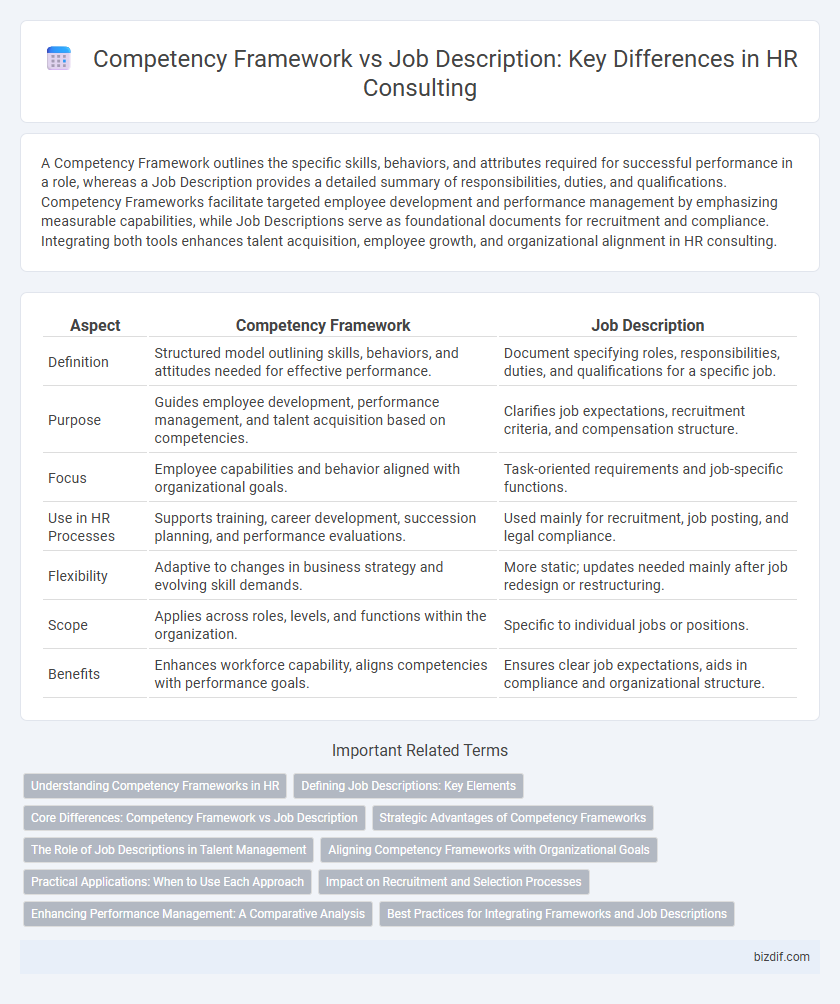A Competency Framework outlines the specific skills, behaviors, and attributes required for successful performance in a role, whereas a Job Description provides a detailed summary of responsibilities, duties, and qualifications. Competency Frameworks facilitate targeted employee development and performance management by emphasizing measurable capabilities, while Job Descriptions serve as foundational documents for recruitment and compliance. Integrating both tools enhances talent acquisition, employee growth, and organizational alignment in HR consulting.
Table of Comparison
| Aspect | Competency Framework | Job Description |
|---|---|---|
| Definition | Structured model outlining skills, behaviors, and attitudes needed for effective performance. | Document specifying roles, responsibilities, duties, and qualifications for a specific job. |
| Purpose | Guides employee development, performance management, and talent acquisition based on competencies. | Clarifies job expectations, recruitment criteria, and compensation structure. |
| Focus | Employee capabilities and behavior aligned with organizational goals. | Task-oriented requirements and job-specific functions. |
| Use in HR Processes | Supports training, career development, succession planning, and performance evaluations. | Used mainly for recruitment, job posting, and legal compliance. |
| Flexibility | Adaptive to changes in business strategy and evolving skill demands. | More static; updates needed mainly after job redesign or restructuring. |
| Scope | Applies across roles, levels, and functions within the organization. | Specific to individual jobs or positions. |
| Benefits | Enhances workforce capability, aligns competencies with performance goals. | Ensures clear job expectations, aids in compliance and organizational structure. |
Understanding Competency Frameworks in HR
Competency frameworks in HR define the skills, behaviors, and attributes required for effective performance across roles, offering a strategic approach to talent management beyond traditional job descriptions. Job descriptions focus on specific duties and responsibilities, while competency frameworks emphasize capabilities and development potential aligned with organizational goals. Understanding competency frameworks enables HR professionals to design targeted training, improve recruitment accuracy, and foster employee growth, driving overall business success.
Defining Job Descriptions: Key Elements
Defining job descriptions requires outlining key elements such as job title, summary, core responsibilities, required qualifications, and performance criteria to ensure clarity and alignment within the organization. A competency framework complements this by detailing specific behavioral and technical skills necessary for success in a role, promoting consistent talent management and development. Integrating both tools enhances recruitment accuracy and employee performance evaluation in HR consulting practices.
Core Differences: Competency Framework vs Job Description
A competency framework defines the skills, behaviors, and attributes required for effective performance across roles, focusing on employee development and organizational goals. In contrast, a job description outlines specific duties, responsibilities, and qualifications tied to a particular position, serving as a guideline for recruitment and evaluation. While competency frameworks emphasize potential and growth, job descriptions concentrate on immediate role expectations and functional tasks.
Strategic Advantages of Competency Frameworks
Competency frameworks provide HR consulting firms with strategic advantages by aligning employee skills and behaviors with organizational goals, enhancing talent management and succession planning. These frameworks facilitate targeted training and development, improving workforce adaptability and performance consistency across roles. Unlike traditional job descriptions, competency frameworks support dynamic organizational growth by promoting a culture of continuous improvement and strategic capability building.
The Role of Job Descriptions in Talent Management
Job descriptions serve as foundational tools in talent management by clearly outlining role-specific responsibilities, required skills, and performance expectations, enabling targeted recruitment and precise candidate evaluation. They facilitate alignment between employee capabilities and organizational objectives, supporting effective onboarding, development planning, and performance appraisal processes. In contrast to competency frameworks, job descriptions provide concrete task-oriented details essential for defining job scope and guiding daily operations.
Aligning Competency Frameworks with Organizational Goals
Aligning competency frameworks with organizational goals ensures that employee skills and behaviors directly support strategic objectives, enhancing overall performance and productivity. Competency frameworks provide a dynamic, forward-looking approach compared to traditional job descriptions by focusing on capabilities that drive business success. Integrating these frameworks into talent management processes fosters a culture of continuous development aligned with evolving company priorities.
Practical Applications: When to Use Each Approach
Competency frameworks guide talent development and performance management by defining behavioral skills aligned with organizational goals, ideal for long-term workforce planning and leadership growth. Job descriptions provide specific role responsibilities and qualifications, essential for recruitment, compliance, and setting clear expectations in the hiring process. Using competency frameworks supports employee assessments and career pathing, while job descriptions are practical tools for day-to-day operational clarity and role accountability.
Impact on Recruitment and Selection Processes
A competency framework enhances recruitment and selection by clearly defining the skills, behaviors, and attributes required for success, enabling more precise candidate evaluation and reducing hiring bias. Job descriptions provide essential role-specific duties and qualifications, but often lack the depth to assess candidates' potential effectiveness comprehensively. Integrating competency frameworks with job descriptions leads to more targeted talent acquisition, improving quality of hires and alignment with organizational goals.
Enhancing Performance Management: A Comparative Analysis
Competency frameworks provide a detailed map of the skills, behaviors, and attributes required for effective performance, enabling tailored development plans and more accurate performance evaluations. Job descriptions offer a static outline of roles and responsibilities but often lack the depth needed for dynamic performance management and growth tracking. Integrating competency frameworks with job descriptions enhances clarity, aligns expectations, and drives continuous employee development, resulting in improved organizational performance.
Best Practices for Integrating Frameworks and Job Descriptions
Integrating competency frameworks with job descriptions enhances clarity in role expectations and performance metrics by aligning skills, behaviors, and responsibilities systematically. Best practices involve mapping core competencies to specific job tasks, ensuring both documents are regularly updated to reflect evolving organizational goals and market demands. Leveraging technology platforms for seamless integration supports consistency in recruitment, training, and performance management processes.
Competency Framework vs Job Description Infographic

 bizdif.com
bizdif.com